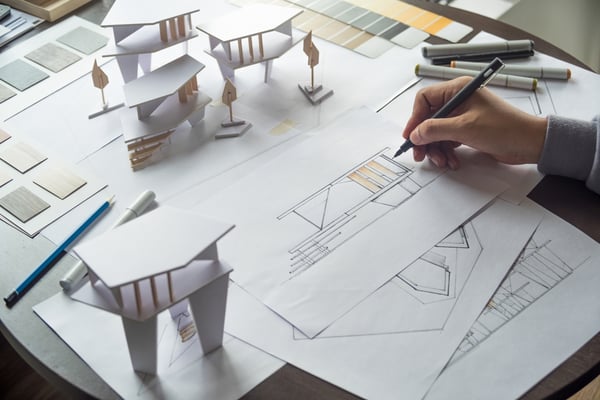Architects are professionals who work in the planning and design of a building or structure. They have the ability to analyze concepts or ideas from their clients and create unique construction designs based on them.
Architect jobs can vary: some specialize in residential or commercial building design, while others focus on landscaping, urban development, interior design and green buildings. There is also a branch of architecture that deals with industrial facilities. The main areas of expertise of architects are summarized below:
- residential
- Commercial
- Landscaping
- Interior architecture
- Urban design
- Green Building Project
- Industrial Architecture
Get a professional MEP design for any building architecture.
Residential Architects
Residential architects design homes, working with homeowners to come up with custom designs or renovations. Residential architects also work with developers and home builders, who can offer predetermined home designs to their clients.
Most residential architects work directly with their clients and are responsible for designing the entire suite of plans. They also provide cost estimates for materials and labor, as well as the construction schedule. The main challenge for residential architects is delivering customized designs based on homeowners' needs, which are often subjective and non-technical.
Commercial Architects
Commercial architects design office buildings, skyscrapers, hotels, multifamily residential buildings, and other buildings that serve commercial purposes. Typically, commercial architects specialize in a specific type of building. They are responsible for creating functional building designs that provide efficient circulation for building users.
Circulation is one of the main factors to consider in these buildings, as the ideal is for occupants to be able to find their way around. Commercial architects must be aware of building codes, safety regulations, local laws, and material costs. They must balance engineering, artistic and construction skills.
Get a high-performance MEP design for your commercial construction project.
Landscape Architects
Landscape architects design outdoor spaces such as parks, gardens, campuses and neighborhoods. They design these spaces to be pleasant for people and harmonious with the environment.
These architects are responsible for the location of buildings, green areas, paths and walkways. They are responsible for deciding on the materials for the sidewalks, the type of trees and shrubs, etc. Landscape architects need a particular set of skills, as they must have knowledge about circulation, horticulture, climate and soil composition.
Interior Architects
Interior architects are responsible for the interior spaces of buildings, as their name implies. Ideally, they should make the most of their living space. These architects have a vast knowledge of colors, fabrics, textures, furniture and other interior elements.
Interior architecture is necessary in both residential and commercial buildings, and popular architects specializing in this field will be in high demand throughout the year. It's important to note that not all interior designers are interior architects, but they can offer similar services. Interior architects have higher qualifications and licenses.
Urbanist Architects

Urban design architects are responsible for designing entire neighborhoods, districts, and cities. Architects with this specialization must combine building architecture and landscaping: they are responsible for grouping buildings and designing nodes, paths, skylines and road networks.
Urban design projects are among the most complex in architecture, as there are many aspects to be considered before finalizing the project. Urban architects will serve an entire community, which can be a difficult but rewarding task.
Green Design Architects
Eco-design architects are gaining popularity since building owners have become more concerned about reducing their environmental impact. These architects design homes and buildings using the most environmentally friendly techniques and often collaborate with architects in other specialties.
Green building designs implement measures such as renewable energy sources, environmentally friendly materials, energy-efficient appliances and other “green” techniques. Green architects are constantly developing new techniques to deliver projects with minimal environmental impact. Areas of knowledge required for green building design include aerodynamics, daylighting and shading.
Industrial Architects
Industrial architects work with manufacturing facilities and other industrial buildings. Because efficiency is a high priority in industrial environments, a key concern is having a building layout that simplifies workflows.
Industrial architects can maximize the utility of available space by optimizing its layout. Factory workers can organize materials and equipment more effectively if the space is easy to navigate. To deliver efficient and functional projects, industrial architects must understand the processes that will be carried out internally.

